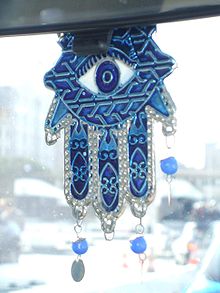Hamsa
Hamsa (arap. خمسة, khomsah — pet) bliskoistočna je amajlija u obliku ljudske šake. Sem na Bliskom istoku, popularna je i u severnoj Africi, gde je obično u upotrebi kao nakit ili se kači na zid.[1][2] Kako predstavlja otvorenu šaku, ova amajlija je korišćena kao zaštita mnogih semitskih naroda od urokljivog oka.

U avramskim religijama, hamsa ima posebne nazive, pa je muslimani nazivaju Fatiminom (prema Muhamedovoj ćerki Fatimi Zahri), Jevreji Mirjaminom, a hrišćani Marijinom rukom (prema Isusovoj majci). Naziv na arapskom jeziku znači pet, jer šaka na amajliji ima pet prstiju — magičan broj za stare Semite.[3][4][5]
Svoje poreklo petoprsta ruka vodi iz Mesopotamije. Ovaj simbol je prisutan na artefaktima posvećenim asirsko-vavilonskim boginjama Ištar i Inani kao opšti znak zaštite.[2] Kod turkijskih naroda, istu namenu ima suzolika amajlija nazar, dok je kod hrišćana približni ekvivalent krstić, ogrlica sa simbolom ove veroispovesti.
Izvori
uredi- ^ Bernasek, Lisa; Peabody Museum of Archaeology and Ethnology; Burger, Hillel S. (2008). Artistry of the everyday: beauty and craftsmanship in Berber art (Illustrated izd.). Peabody Museum Press, Harvard University. str. 12. ISBN 0-87365-405-6.
- ^ a b Sonbol, Amira El Azhary (2005). Beyond the exotic: women's histories in Islamic societies. Syracuse University Press. str. 355—359. ISBN 0-8156-3055-7.
- ^ Zenner, Walter P. (1988). Persistence and flexibility: anthropological perspectives on the American Jewish experience (Illustrated izd.). SUNY Press. str. 284. ISBN 0-88706-748-4.
- ^ World Institute for Advanced Phenomenological Research and Learning (Belmont, Estados Unidos) (1991). Anna-Teresa Tymieniecka, ur. Roman Ingarden's aesthetics in a new key and the independent approaches of others: the performing arts, the fine arts, and literature, Volume 3. Springer. str. 219. ISBN 0-7923-1014-4.
- ^ Drazin, Israel (2009). Maimonides and the Biblical Prophets. Gefen Publishing House Ltd. str. 268. ISBN 965-229-430-6.
Spoljašnje veze
uredi
Literatura
uredi- Drazin, Israel (2009). Maimonides and the Biblical Prophets. Gefen Publishing House Ltd. str. 268. ISBN 965-229-430-6.
- Zenner, Walter P. (1988). Persistence and flexibility: anthropological perspectives on the American Jewish experience (Illustrated izd.). SUNY Press. str. 284. ISBN 0-88706-748-4.
- World Institute for Advanced Phenomenological Research and Learning (Belmont, Estados Unidos) (1991). Anna-Teresa Tymieniecka, ur. Roman Ingarden's aesthetics in a new key and the independent approaches of others: the performing arts, the fine arts, and literature, Volume 3. Springer. str. 219. ISBN 0-7923-1014-4.
- Bernasek, Lisa; Peabody Museum of Archaeology and Ethnology; Burger, Hillel S. (2008). Artistry of the everyday: beauty and craftsmanship in Berber art (Illustrated izd.). Peabody Museum Press, Harvard University. str. 12. ISBN 0-87365-405-6.
- Sonbol, Amira El Azhary (2005). Beyond the exotic: women's histories in Islamic societies. Syracuse University Press. str. 355—359. ISBN 0-8156-3055-7.